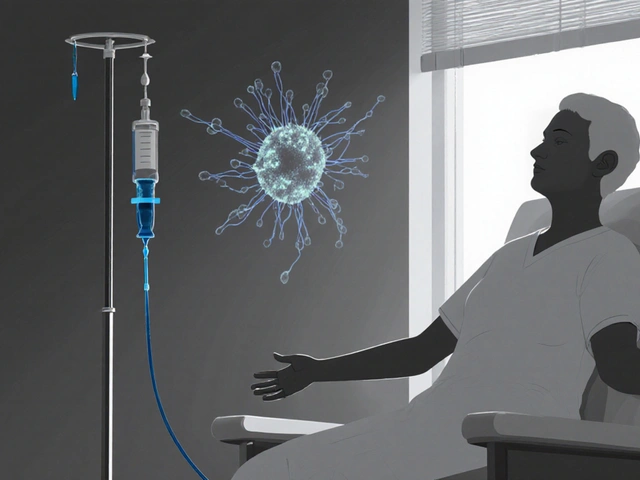Wondering if ethinylestradiol is the right choice for your hormone therapy? You're not alone. This synthetic form of estrogen plays a significant role in hormone treatments, especially for transgender women. But how exactly does it work, and what should you expect?
First things first, ethinylestradiol helps in developing certain feminine physical characteristics, which can be crucial for those transitioning from male to female. It's not without its complexities, though. There are benefits, like softer skin and reduced body hair, but also potential risks you need to be aware of.
Incorporating it into your therapy requires careful planning and consultation with health professionals. This way, you can tailor the treatment to meet your specific needs while keeping health risks in check. Stick around as we delve deeper into what makes ethinylestradiol tick in hormone therapy.
- What is Ethinylestradiol?
- Role in Male Hormone Therapy
- Benefits of Ethinylestradiol
- Potential Risks and Side Effects
- Tips for Managing Therapy
- Expert Opinions
What is Ethinylestradiol?
Let's dive right into understanding ethinylestradiol. It's a synthetic estrogen, which means it's a man-made version of a hormone that the body naturally produces. Primarily, it's used in combination with other hormones for birth control pills, but it also plays a significant role in male hormone therapy, especially for transgender women.
Origin and Composition
Ethinylestradiol is derived from 17α-ethinyl estradiol and mimics the functions of estrogen. This tiny tweak in its chemical structure allows it to be absorbed effectively when taken orally. Because of this, it's a preferred option when prescribing estrogen therapy.
How Does it Work?
The primary role of ethinylestradiol in hormone treatment is to foster the development of female secondary sexual characteristics. This includes breast growth, softer skin, and redistributing body fat to more typical female patterns.
Here's the science bit: it binds to estrogen receptors in the body, influencing how certain genes are expressed. This can lead to the desired feminizing effects over time.
Absorption and Metabolism
When taken, ethinylestradiol is absorbed quickly through the gastrointestinal tract. It then undergoes metabolism in the liver. An interesting fact is that it has a stronger impact on the liver compared to natural estrogen, which is why monitoring during therapy is crucial.
Other Uses
While its main application is in transitioning therapies, ethinylestradiol is also found in contraceptives. However, dosages differ when used in gender-affirming treatments.
Understanding ethinylestradiol and its usage could be the first step towards a successful hormone therapy journey. Always discuss with your healthcare provider to align the treatment with your individual goals and needs.
Role in Male Hormone Therapy
When it comes to male hormone therapy, ethinylestradiol has carved out a significant role, especially for transgender health. This synthetic estrogen helps transgender women transition by bringing about physical changes aligned with their gender identity.
Understanding Its Function
Essentially, ethinylestradiol works by supplementing the body with estrogen, which is crucial for the development of female secondary sexual characteristics. This includes breast development, fat redistribution, and reduction of muscle mass.Why Choose Ethinylestradiol?
One of the primary reasons ethinylestradiol is favored in male hormone therapy is its effectiveness in producing noticeable changes. It's often considered when quick and evident results are desired in comparison to other forms of estrogen.Administration Methods
There are several ways to take ethinylestradiol—oral tablets, transdermal patches, or injectable forms. Each method has its pros and cons, and it's vital to consult healthcare providers to decide what's best for you.- Oral Tablets: Easy and convenient but may have a higher risk of liver side effects.
- Transdermal Patches: Offer a steady release but could be less effective in some cases.
- Injectable Forms: Can deliver the hormone more directly but might require regular visits to a healthcare provider.
Choosing the right method depends on individual preferences and medical advice.
Potential for Results
Don't expect overnight miracles. While some changes might be seen within a few months, significant results can take a year or more. Patience and consistency are key. Regular monitoring and adjustment by your healthcare provider are essential to achieving the desired outcomes effectively and safely.Remember to stay informed and proactive during your transition journey. Each body reacts differently, so what works for one person might not work for another. Keep an open dialogue with your healthcare team to ensure the best possible results with hormone treatment.
Benefits of Ethinylestradiol
So, what makes ethinylestradiol such a buzzword in male hormone therapy? Well, it’s primarily used to help transgender women align their physical appearances with their gender identity. Here are some of the notable benefits:
Feminization Effects
One of the primary reasons people turn to ethinylestradiol is its potent ability to promote feminization. This includes the development of softer skin, reduced body hair, and potential breast growth. These changes can significantly boost confidence and improve quality of life for many transitioning individuals.
Psychological Wellbeing
Besides physical transformations, there’s often an underrated but crucial psychological benefit. Feeling comfortable in your skin can greatly enhance mental health. Many individuals report reduced anxiety and depression symptoms once they start achieving their desired physical changes.
Regulation of Hormones
Ethinylestradiol does a fantastic job of regulating hormone levels, ensuring a stable hormone balance. This can help improve overall wellbeing and reduce the physical stress associated with hormone imbalances.
| Benefit | Impact |
|---|---|
| Feminization | Physical transformation, improved self-esteem |
| Mental Health | Reduced anxiety, better psychological wellbeing |
| Hormone Balance | Stable hormone levels, enhanced overall health |
It’s important to remember that while ethinylestradiol offers numerous benefits, individual experiences will vary. Regular consultations with healthcare providers can help tailor the treatment to maximize benefits while minimizing risks.

Potential Risks and Side Effects
Like any medication, ethinylestradiol in male hormone therapy can have its share of risks and side effects. Understanding them is crucial for anyone considering this treatment. While it's effective in inducing desired physical changes, there are potential issues to be cautious about.
Common Side Effects
Some of the more common side effects include nausea, headaches, and changes in weight. These might seem minor, but they can impact your daily life if not managed properly. Good news? They often stabilize as your body gets used to the hormone.
Serious Health Risks
Now, let’s dive into the details. One major risk is an increased chance of developing blood clots. This risk is higher if you smoke or have a history of cardiovascular issues. Regular check-ups with your healthcare provider are important to catch any early signs that might warrant attention.
Another potential risk involves the liver. Long-term use of high doses may affect liver function, so liver enzyme levels need monitoring throughout treatment. It's a small step that makes a big difference!
Emotional and Mental Health
There can be psychological effects too. Mood swings or emotional changes happen in some individuals. It’s vital to stay connected with mental health professionals to navigate these shifts smoothly.
Monitoring and Consultation
Keeping tabs on your health through regular consultations ensures any adverse effects are caught early. Remember, communication is key. Always talk with your doctor about any worrying changes you notice.
Want a quick look at the data? Here’s something to ponder:
| Common Side Effect | Frequency |
|---|---|
| Nausea | 20% |
| Headache | 15% |
| Weight Changes | 10% |
No treatment is without its hurdles, but understanding and preparation can help you manage ethinylestradiol's effects effectively. Being informed means you have the best chance of a successful and safe transition.
Tips for Managing Therapy
Embarking on male hormone therapy with ethinylestradiol requires mindfulness and a proactive approach. It's all about finding the right balance that works for your body and goals. So, what should you keep an eye on?
Consultation is Key
Your journey should start with a detailed discussion with a healthcare professional. They can help customize your dosage and address any concerns. Don’t skip those appointments! Regular follow-ups ensure everything stays on track.
Monitor Your Health
Keep tabs on any changes you notice, good or bad. It's common to experience shifts in mood or energy levels in the beginning. If anything feels off, reach out to your doctor — they're there to help.
Understand the Side Effects
You may encounter side effects like nausea or headaches. Knowing these potential bumps on the road helps you manage them better. Your doctor can suggest ways to mitigate these discomforts.
Stay Informed
There are many trusted resources available to help you understand how hormone therapy works. Books, online forums, and support groups can offer comfort and advice from others who have been there.
Nutritional Support
- A balanced diet can make a vast difference. Prioritize foods rich in nutrients that support hormone balance, like leafy greens and lean proteins.
- Stay hydrated. Water helps in processing and regulating hormones.
Avoid Self-Medication
The temptation to tweak your dosage might arise, but resist it. Always consult a healthcare provider before making any changes to avoid potential complications.
| Aspect | Recommendation |
|---|---|
| Health Check-ups | Every 6 months |
| Diet | Nutrient-rich, well-balanced |
| Hydration | 2-3 Liters of water daily |
By sticking to these tips, your journey with ethinylestradiol can be smoother and safer. Remember, each body is unique, so tailor these steps to fit your needs.
Expert Opinions
When it comes to ethinylestradiol in male hormone therapy, experts emphasize a well-rounded understanding of both benefits and risks. Conversations with endocrinologists and healthcare providers can make all the difference in ensuring the therapy is safe and effective.
Insights from Healthcare Professionals
Dr. Lisa Thompson, an endocrinologist specializing in transgender health, notes that while ethinylestradiol is effective in feminizing hormone therapy, it requires precise dosing. "The goal is always to find the lowest effective dose that minimizes side effects while achieving desired results," she mentions.
She also emphasizes regular monitoring through blood tests, which is crucial for tracking hormone levels. "These check-ups ensure the therapy is progressing well and the individual isn't exposed to unnecessary risks," Dr. Thompson adds.
Consideration of Side Effects
It's not all smooth sailing, of course. Dr. Mark Evans, another expert in hormone treatment, warns against ignoring side effects. "Common issues like headaches or nausea might occur, but more severe risks, such as cardiovascular problems, need attention," he explains. He suggests keeping a close check on any symptoms and adjusting treatment as necessary.
Long-Term Benefits
Experts also highlight the positive impact of ethinylestradiol on mental health. Many individuals report feeling more aligned and comfortable in their skin, which can boost confidence and reduce gender dysphoria. Dr. Thompson points out, "Beyond physical changes, the psychological benefits can be profound, providing a significant improvement in quality of life."
For anyone considering this path, consulting with well-versed professionals offers reassurance and the knowledge to navigate hormone therapy effectively.







11 Comments
This is a pretty interesting topic and definitely relevant for a lot of folks figuring out hormone therapies. I appreciate that the article touches not just on benefits but also the risks, which can be overlooked sometimes. Hormones are a tricky thing because everyone reacts differently, so having expert insights is really valuable.
Does anyone have personal experience with ethinylestradiol as part of their regimen? I wonder about how manageable the side effects are long term. Also curious about any natural or lifestyle adjustments that might help balance the therapy.
Thanks for sharing this post, it’s great to see more open discussion about trans health topics.
From a clinical perspective, ethinylestradiol, while effective, has some notable risks particularly related to cardiovascular health. It’s essential for patients and providers to closely monitor these aspects during therapy. Careful management can mitigate many issues but awareness is key.
Also, it's worth mentioning that alternative estrogens like estradiol valerate might be safer options. I think clear communication between the doctor and patient about these choices can really ensure a smoother transition process.
Has anyone here had doctors who explained these differences clearly? It makes a huge difference to understand what you're working with.
Great points being raised about risks. I’m curious: does the route of administration (oral vs. injection vs. topical) of ethinylestradiol affect how risks manifest? I’ve read that oral forms might carry more risk for blood clots but am not sure how significant that difference really is.
For those managing their dosages, how controllable are hormone levels when ethinylestradiol is used compared to other estrogens? It’s fascinating but also complex. Any firsthand accounts would be really helpful.
I just wanted to add that it's not just about physical effects. Mental health and mood can change so much during hormone therapy. I hope more articles like this keep discussing those aspects too, so people know what to expect beyond just the science.
Sometimes managing mood swings or emotional shifts is the hardest part for people starting on these treatments. And having good support networks really makes a world of difference.
Does the article mention resources for mental health support during transition at all? That would be such an important inclusion to me.
Oh come on, are we really still talking about ethinylestradiol like it’s some magic bullet? It’s been around forever, plenty of controversy over its safety. People need to wake up to the potential damage this stuff can do, especially long-term. It’s not just rosy effects and benefits like some promos would have you believe.
Anyone jumping in without doing thorough research is playing with fire. I’ve seen the drama unfold in clinical circles – and it ain’t pretty. If you really care about your health, look beyond the hype.
Thanks for the strong perspective. I get where you’re coming from and agree that caution is critical. The article aims to present a balanced view – yes, there's risk, but also real benefits when managed responsibly.
Ethinylestradiol isn’t for everyone, but for some in transition it represents an important part of their journey. It’s always about weighing options and having informed discussions with healthcare providers.
Would love to hear more about your experiences or knowledge on safer alternatives that might provide similar benefits but with fewer concerns.
Honestly, people freaking out about ethinylestradiol safety just because it’s old school is kinda ridiculous. It's been used for decades, doses can be controlled, risks monitored. The fearmongering around it can cause unnecessary anxiety.
Really, the devil’s in the details — the patient’s health background, the dose, the monitoring routine, those are what determine outcomes, not just the hormone compound itself.
I’d say the drama fans need to chill and focus on facts rather than emotions. There’s a reason clinicians have stuck with ethinylestradiol for so long.
While I see the points about long history and monitored use, let’s not completely sketch over the risks that have been documented, especially in certain populations. The judgement should remain evidence-based and cautious with these kinds of therapies.
Some newer formulations and protocols have indeed reduced side effects significantly, but blanket acceptance isn’t wise. Patient-centered care means tailoring to individual risk profiles carefully.
I hope future research will keep improving our options and making these treatments safer and more accessible.
To clarify a few technical points, yes, oral ethinylestradiol is linked to higher thrombotic risk compared to transdermal or injectable estrogen forms. The metabolism through the liver when taken orally can upregulate clotting factors.
Therefore, for patients with risk factors such as smoking or hypertension, alternative delivery methods are often recommended. This nuanced approach is essential to older and younger patients alike.
Having worked in endocrinology, I've seen how individualized therapy plans make the biggest difference, and patient education about these risks is crucial.
What stands out to me here is just how deeply personal hormone therapy is. The science and clinical info are foundational, but the human side—the hopes, the fears, the daily realities—are what truly matter.
Ethinylestradiol might be one part of the story, but the narratives of those living through their transitions shape the context. Encouragement, respect, and access to solid support systems are what allow these journeys to flourish.
That’s why sharing these articles and stories openly is vital—it normalizes experiences and educates an often unaware public.
Philosophically speaking, the interplay of hormones in identity transformation is profound and complex. Ethinylestradiol acts as a tool that reshapes physiology, but also potentially one’s sense of self and social interactions.
What fascinates me is how biochemical interventions mediating gender affect not only the body but ripples through psychological and cultural dimensions. Is there adequate discourse on these layered impacts beyond the clinical?
I’d love more interdisciplinary dialogues around this. How do others reflect on the multi-faceted nature of hormone therapies beyond the biological effects?
Write a comment